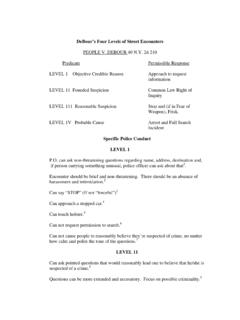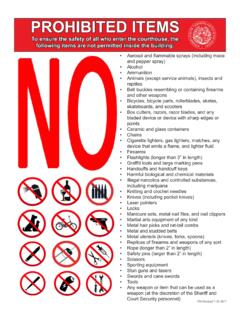Transcription of ADVANCEMENTS IN BRAIDED - A&P Technology
1 ADVANCEMENTS IN BRAIDED MATERIALS Technology Mike Braley and Molly Dingeldein A&P Technology , Inc. Cincinnati, Ohio 45245 ABSTRACT Until now, the automated material processes used to manufacture large, composite aerospace structures have been filament winding, automated tape layup, and fiber placement. An overview of the ADVANCEMENTS in BRAIDED preform architectures and braiding machinery identify braiding as an attractive process alternative for composite manufacturers. State-of-the-art braiding equipment incorporates fully automated control over all braiding parameters, including translational and rotational control of the mandrel, a vision system for real-time inspection, a laser projection system and integrated circumferential winding.
2 These technological ADVANCEMENTS , in addition to the high rate of material deposition found with braiding approach the precision demonstrated by fiber placement systems and the cost efficiency found in filament winding and is applicable to the manufacture of large scale, structural preforms. KEY WORDS: Braider, Carrier, Coverage, Unit Cell, Near Net Shape Preforming, Triaxial, Megabraider 1. INTRODUCTION Historically, braiding has been recognized as a textile process enabling the production of commodities such as cordage and candlewick. These textile products are mass produced on standard braiding machinery using small denier yarns, such as cotton, nylon, polyester or fiberglass.
3 Over the past century the standard braiders - braiding machinery with 144 or less carriers (spools of yarn) have proven to be extremely economical. For example, the setup of a standard 3 carrier machine used to make candlewick requires less than five minutes of labor, and this one setup allows for a continuous run time of one week yielding over 3600 yards of braid. With the onset of preform Technology in the late 1940s, came a new interest in braid as a structural reinforcement rather than an end product. The unique Chinese finger trap -like architecture gives BRAIDED material a high level of conformability, allowing it to assume extremely complex shapes.
4 Braid s architecture and the efficiencies of the manufacturing process caught the attention of materials engineers, and in the 1980s, braid gained recognition as a viable alternative to woven or stitched fabric for structural reinforcement. Once braid s effectiveness was realized, so too was a need for larger braiding machinery that would include extensive process Technology in order to meet the demands of technologically advanced applications. 2. MEGABRAIDERS Engineers at General Electric Aircraft Engines (GEAE) were among the first to choose braid as an alternative to woven fabrics. GEAE engineers were looking to reduce the weight of the fan blade containment structure of their commercial jet engines that utilize a woven kevlar wrap.
5 In subscale testing, braid proved to be more efficient than woven, knit and non-woven structures. Yet, the production width of the BRAIDED tape needed for the containment belt was in excess of twenty-two inches and standard braiding machines were not capable of producing a fabric of that width. In order to meet GEAE s requirements, A&P Technology designed and built a 400 carrier braiding machine. This new machine was capable of incorporating the number of ends necessary to create the desired width while maintaining the required coverage and the machine itself represented the first venture beyond standard braiding machinery. Soon after the development of the 400 carrier braider, another customer approached A&P Technology with a need for a BRAIDED solution requiring the use of non-standard machinery.
6 In the early 1990s, ASD Simula of Phoenix, Arizona wanted to use braid in the development of its side impact airbag for automobiles. In this application the Chinese handcuff action of the braid is used in reverse. By inflating a biaxial braid internally the braid expands in diameter and shrinks in length. ASD harnesses this phenomenon to create a device that is stowed in an elongated configuration. Upon inflation, the airbag self deploys into a position to cushion a vehicle occupant s head in event of a side impact. While a braid made on any size machine would accommodate the requirement of shrinking in length while expanding in diameter, only braid made on an extremely large machine would meet the coverage requirements of this application.
7 The tubular airbag needs to provide full coverage for the bladder at the inflated diameter, so that it can handle internal pressurization without damage. At the same time the structural requirements of the airbag require that the fibers are oriented at a low angle at the inflated diameter. This move towards lower angle reduces the effective width of each yarn and its contribution to coverage. Without full coverage, areas of the bladder would not be supported by the braid between yarn crossings. In these regions aneurysms in the bladder and consequential failure in the airbag system could occur. In order to achieve the design criteria of low fiber orientation and high coverage simultaneously, A&P Technology chose to produce the BRAIDED structure on a 600 carrier braiding machine.
8 This increase in machine size allowed for the production of a high coverage braid with small unit cells and the appropriate fiber orientation for the airbag braid. (A unit cell is a textile term describing the openings or voids between yarn crossings. Smaller unit cells imply that the interstices or openings between yarns are reduced in size.) The combination of small yarns and increased coverage optimized the braid design. The small yarns allowed for decreased friction and smoother deployment and the increased coverage (the increase in the number of yarn bundles) prevented the occurrence of aneurysms. At this point, A&P Technology realized the potential for large braiders, Megabraiders, and established a line with machines ranging from 172 to 800 carriers.
9 This range of sizes allowed braid designers a wide array of design options enabling an efficient method for product development, yet these development projects revealed a new set of issues surrounding the manufacture of braid for structural reinforcements. 3. DEMAND FOR GREATER EFFICIENCY With the transition from the use of braid for candlewick to the use of braid for structural applications, including structural composites, came an increased demand for specific technical requirements. As stated earlier, braid s ability to conform to complex shapes is an attribute that attracts many designers to examine the use of braid. In addition, the braiding process is amenable to near net shape preform manufacturing.
10 This type of manufacturing is ideal for those designers interested in a reduced layup time and a process that is repeatable. The braiding machine places two or three sets of yarns simultaneously; therefore, in contrast to a series of unidirectional lamina, a BRAIDED composite is composed of a series of multi-directional plies having identical properties. Since the properties of each lamina are the same, the likelihood of delamination is reduced dramatically. In addition to a reduction in interlaminar stresses, previous testing has shown that BRAIDED laminates provide increased interlaminar strength and damage tolerance as a result of a nesting phenomenon at the ply interfaces.






